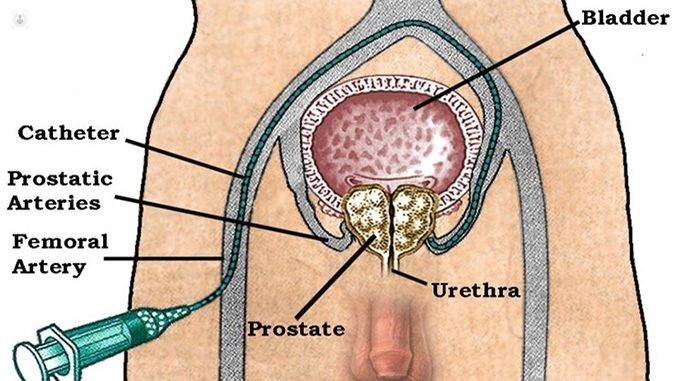Interventional radiology in men’s health: PAE
Escrito por:Interventional radiology is a specialty where a doctor trained in medical imaging uses X-rays and scans to guide treatment to practically any organ in the body. The X-rays are used to guide fine tubes (catheters) from the access point, which is either the main artery at the top of the thigh or the artery in the wrist, to the target area where treatment is needed. Recently, there has been exciting research into how IR can help with common problems affecting men’s health, including an enlarged prostate.

What’s interventional radiology used to treat?
IR techniques are used to treat cancer, benign non-malignant growths, blocked blood vessels or even blocked passages in the kidney, liver or the bowel. Interventional radiologists can implant devices, perform advanced diagnostics procedures, treat pain or even regulate high blood pressure.
Now, in using the procedure prostate artery embolization (PAE), interventional radiologists can treat enlarged prostates. This is a very common condition and around half of men have some prostate enlargement by the age of 50, and this rises with increasing age.
What is an enlarged prostate?
The prostate gland is an organ, which is found at the base of the bladder. The urinary passage (urethra) passes through this organ. The normal function of the prostate gland is to produce enzymes and fluids that are important in sexual function. As men get older, the prostate can enlarge (benign prostatic hyperplasia) and this growth is normally a non-cancerous growth.
S ince the urethra passes through the prostate, an enlargement in the prostate can squeeze the urethra and cause difficulties in passing urine. Men often complain of a poor flow, passing urine often and particularly at night, and a feeling of not being able to empty the bladder.
ince the urethra passes through the prostate, an enlargement in the prostate can squeeze the urethra and cause difficulties in passing urine. Men often complain of a poor flow, passing urine often and particularly at night, and a feeling of not being able to empty the bladder.
What’s the procedure for prostate artery embolization (PAE)?
The prostate artery, just like any other organ, has a blood supply and usually, there are two; a right and a left. PAE involves guiding a very fine tube into these arteries. X-rays guide the tube into these blood vessels. A needle is placed into the skin over the artery at the top of the thigh or over the artery in the wrist with a local anaesthetic given.
A fine tube, or a sheath, can be guided into the blood vessel. Angiograms (X-rays with dye injection) are taken to find the prostate arteries and then once the catheter is placed into these arteries, fine plastic particles are injected. The particles block off the blood supply to the prostate, causing it to shrink and relieve the constriction on the urethra.
Once the blood supply is blocked, all of the catheters and needles are removed and a dressing is applied to finish the procedure. Patients are able to eat and drink and are sent home following a few hours of recovery.
The minimally invasive treatment does not affect sexual functions and allows patients to get back to work and normal activities within a few days.



